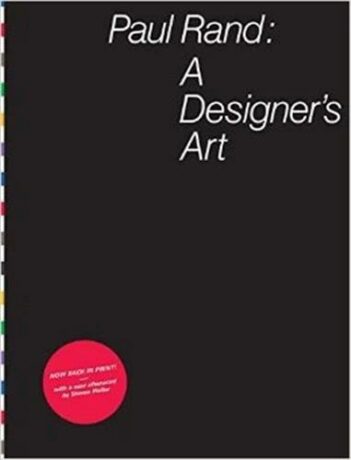A Designer’s Art «P aul Rand is an idealist and a realist, one who uses the language of the poet and the businessman. He thinks in terms of need and function . . . but his fantasy is boundless.» -L. Moholy-Nagy Paul Rand (1914 -96) was incontestably one of the leading graphic designers of the twentieth century. His pioneering work in the field of advertising design and typography exerted a profound influence on the design profession. Applying the lessons of modern art, particularly those of the Bauhaus, to art in the service of business, he almost single-handedly transformed «commercial art» from a practice that catered to the lowest common denominator of taste to one that asserted its place among the fine arts.
Paul Rand: A Designer’s Art brings together many of Rand’s best essays on design and a wide selection of his brilliant graphic work from the 1930s to the 1980s. This book reprises the essays from his classic 1947 text, Thoughts on Design, most of which were updated by Rand in 1984. It also covers his subsequent work in advertising design, corporate identity, design teaching, and typography- areas in which he created exemplary and inventive work. Among the topics he explores are the role of humor in design, the trademark (the most ubiquitous of Rand’s trademarks are those of IBM, ABC, UPS, and Westinghouse), design and the play instinct, the complexity of color, the role of symbols, the art of the package, and the politics of design. Each of the essays is illustrated with examples of Rand’s work-posters, book jackets, product advertisements, corporate trademarks, packaging, interiors-as well as the work of artists he admired.
For the design student, teacher, professional designer, and, indeed, for anyone interested in the creative communication of ideas, Paul Rand: A Designer’s Art remains both provocative and enlightening.
À travers 27 essais, Paul Rand donne à voir ses méthodes de travail et inspirations sous un angle privilégié. Il y détaille les principes théoriques qu’il s’est attaché à suivre et a tenté d’appliquer tout au long de sa carrière, mais revient également sur son rapport aux clients et sa perception du travail de commande en design graphique.
À la différence d’un grand nombre de monographies, le présent ouvrage interroge la pratique du design sous l’angle de la réflexion, et non uniquement sur le plan visuel.
Il en résulte ainsi un livre qui vise non seulement à être regardé, mais également à être lu. Chacun de ces essais mêle références artistiques et littéraires et témoigne de l’importance de la pluridisciplinarité dans le travail de Paul Rand.
L’ouvrage est l’unique source d’information de cette ampleur sur le travail de Paul Rand à l’heure actuelle en France, ce livre a été conçu par l’auteur comme étant celui à travers lequel il souhaitait synthétiser l’ensemble de sa pratique. Il revient ainsi à la fois sur son travail de design de logos pour des grandes marques, mais décrit également ses projets de design de couvertures de livre ou de magazines pour des structures plus modestes.
Cet inventaire non-exhaustif du travail de Paul Rand se révèle être un véritable outil pour les étudiants, enseignants et professionnels en design graphique soucieux de perfectionner leur pratique et de se questionner sur leur travail. Cet ouvrage s’attache en effet à montrer comment certains principes fondamentaux et intemporels qui encadrent la pratique du design – comme ceux de l’équilibre, l’harmonie des couleurs et la gestion de l’espace – peuvent être détournés pour être perçus sous un angle nouveau.
Pages
248
Langue
Français
Date d'édition
novembre 2021
Taille
19 x 25.4 cm
Éditeur
Editions B42
Poids
600 gr










